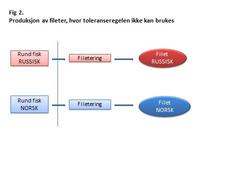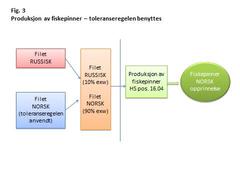Use of third-country materials
Use of third-country materials
Depending on the relevant free trade agreement, you may use 10 %, 15 % or 20 % third-country materials and still maintain Norwegian origin.
The third-country materials must be included in the production of finished goods. This must happen before or during the production process itself (see Figure 1).

You cannot run a production line only with third-party materials in parallel to a line of originating materials and then mix the finished product in order to use the tolerance rule (see Figure 2).

This also applies to periodic production that involves originating materials and non-originating materials on the same production line.
To use the tolerance rule, the admixture of third-country raw material must happen at the beginning of production or during the production of the finished fillet. This is how you ensure that the raw material undergoes the required production and that the third-country raw material cannot be separated from the originating raw material in the finished product.
The fillets will primarily be of Russian and Norwegian origin. You may not use the tolerance rule at a subsequent point.
Note that if the finished fish fillets displayed in Figure 2 are frozen in blocks or individually, it will not be possible to use the tolerance rule. This is because freezing is not regarded as a manufacturing process. If the goods are processed further (for example, into fish fingers), it is possible to mix in Russian fillet that corresponds to 10 % (the EEA agreement) of the value of the finished product (see Figure 3).

Even if we have based these examples on fillet production, the principle of applying the tolerance rule is the same for all type of finished product.
The originating product may be used freely in further production without having to assess the rules of origin for the originating materials that are used in accordance with the rules of origin for the new product.
The finished fish fillets in Fig. 1 will be considered to be 100% of Norwegian origin in any further production. The Norwegian originating materials (where the tolerance rule is used) are used in the manufacture of fish fingers. Since the originating materials are used in a new production, the tolerance rule can be used again in the production of fish fingers, irrespective if the tolerance rule has already been used in the production of fish fillets.
See Article 5 (1)(2) and introductory note no. 3.1 in Annex I to the Origin Protocols.
The tolerance rule has not been "used up" for the fillets from Figure 1. They are of Norwegian origin, and if they are processed further, the tolerance rule can be used in the subsequent production process.
The example in Fig. 3 is the tolerance rule used for the production of the Norwegian fillets, but this does not prevent it from being used when the fillets are part of a production of a new product such as, for example, fish fingers. This follows from the principle that once an item has obtained its origin in accordance with the rules of origin in an agreement, this originating product can freely be used in any further production.
Updated: 07/11/2024